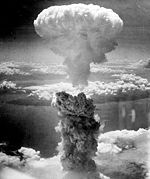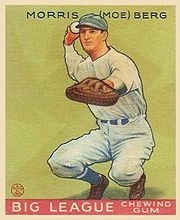- Operation Alsos
-
Operation Alsos (or Alsos Mission) was an effort at the end of World War II by the Allies (principally Britain and the United States), branched off from the Manhattan Project, to investigate the German nuclear energy project, seize German nuclear resources, materials and personnel to further American research and to prevent their capture by the Soviets, and to discern how far the Germans had gone towards creating an atomic bomb. The personnel of the project followed close behind the front lines, first into Italy, and then into France and Germany, searching for personnel, records, material, and sites involved.
Alsos is sometimes mistakenly written ALSOS by sources including the U.S. Army, perhaps because it does not look like a usual English word and is thus falsely assumed to be an acronym. In fact, Alsos is the Hellenic name for "grove", and so this designation is a play on the name of Major General Leslie M. Groves, the military director of the Manhattan Engineering District (the Manhattan Project), the Allied wartime effort to develop an atomic bomb (which itself was sparked out of fears of a German weapon). Groves was the major impetus behind Operation Alsos because of his desire to make sure that German technology and personnel did not fall into Soviet hands, and to prolong for as long as possible the anticipated American monopoly on nuclear weapons.
Samuel Goudsmit was the technical/scientific leader of Alsos, and Lt. Col. Boris Pash, a former Manhattan Project security officer, was its military leader. Major League baseball player, attorney, and linguist Moe Berg contributed in various phases.
The project managed to find and remove many of the German research effort's personnel and a substantial portion of the surviving records and equipment. Most of the senior research personnel (including Werner Heisenberg, Otto Hahn, and Carl Friedrich von Weizsäcker) were sequestered at Farm Hall in England for several months, as part of Operation Epsilon. Their discussions were secretly recorded, and transcripts of those tapes have been released.
In the end, Operation Alsos concluded that the Allies had surpassed the entire German atomic bomb effort by 1942. Compared to the Manhattan Project (one of the largest scientific and engineering projects in history), the German project was considerably underfunded and understaffed, and it is questionable whether Germany would have had the resources or concentrated research attention which the Allies used to produce such a weapon.[citation needed]
In a monograph published two years after the end of the war, Goudsmit concluded that a principal reason for the failure of the German project was that science could not flourish under totalitarianism. Many think that this argument is adequately rebutted by German advances in other realms, such as one of the world's first operational jet fighters (Messerschmitt Me 262) and the first ballistic missile (V-2), as well as the Soviet Union's development of a nuclear weapon by 1949.
Goudsmit is said to have made the statement regarding totalitarianism under "instructions" to support and clear Heisenberg, who personified the new pro-western German scientific order. After Heisenberg's death, Goudsmit revised his statement, claiming that Heisenberg was always working to finish off what he has started, which contrasts with the impression the German project came to a halt through politics.
See also
- German nuclear energy project
- Operation Alsos included Operation Big and Operation Harborage.
- Similar (but separate) attempts to remove German technical information and personnel after the war were:
- Norwegian heavy water sabotage
- Russian Alsos
Further reading
- Jeremy Bernstein and David Cassidy, Hitler's Uranium Club: The Secret Recordings at Farm Hall, 2001.
- Charles Frank, ed. Operation Epsilon: the Farm Hall transcripts, 1993.
- Samuel Goudsmit, Alsos: the failure of German science, 1947.
- Hentschel, Klaus, editor and Ann M. Hentschel, editorial assistant and Translator Physics and National Socialism: An Anthology of Primary Sources (Birkhäuser, 1996)
- Mahoney, Leo J. A History of the War Department Scientific Intelligence Mission (ALSOS), 1943 – 1945. [Ph.D. Dissertation, Kent State University, 1981]
- Pash, Boris. The Alsos Mission. New York: Charter Books, 1969.
- Thomas Powers, Heisenberg's War: The Secret History of the German Bomb, 2000. Powers makes an inferential case that the German effort was, essentially, sabotaged by scientific foot-dragging, perhaps especially by Heisenberg.
- Paul Lawrence Rose, Heisenberg and the Nazi Atomic Bomb Project: A Study in German Culture (Berkeley: University of California Press, 1998), ISBN 0-529-21977-8.
- Mark Walker, German National Socialism and the quest for nuclear power, 1939 – 1949, 1990.
External links
Manhattan Project Sites 
Administrators Vannevar Bush · James Conant · Thomas Farrell · Leslie Groves · Franklin Matthias · Kenneth Nichols · Robert Oppenheimer · William ParsonsScientists Hans Bethe · Niels Bohr · James Chadwick · Arthur Compton · Enrico Fermi · Richard Feynman · Klaus Fuchs · George Kistiakowsky · Ernest Lawrence · William Penney · Emilio G. Segrè · Glenn T. Seaborg · Leó Szilárd · Edward Teller · Richard C. Tolman · Stanislaw Ulam · Harold Urey · Leona Woods · Chien-Shiung WuRelated articles Timeline · History of nuclear weapons · Nuclear weapons and the United States · S-1 Uranium Committee · Chicago Pile-1 · X-10 Graphite Reactor · Y-12 National Security Complex · Operation Alsos · Smyth Report · Project Alberta · 509th Operations Group · Fat Man · Little Boy · Enola Gay · Bockscar · The Great Artiste · Atomic bombings of Hiroshima and Nagasaki (debate) · Atomic Spies · Atomic Energy Act of 1946 · Operation Crossroads · Tube AlloysCategories:- Manhattan Project
- World War II operations and battles of Europe
- Nuclear program of Nazi Germany
- Espionage projects
Wikimedia Foundation. 2010.

